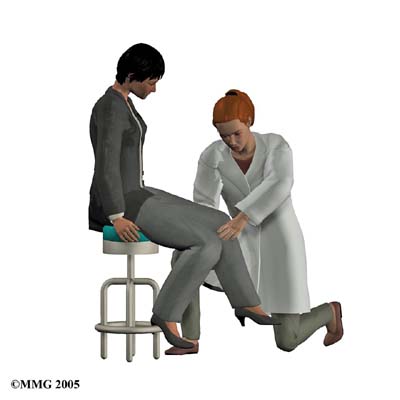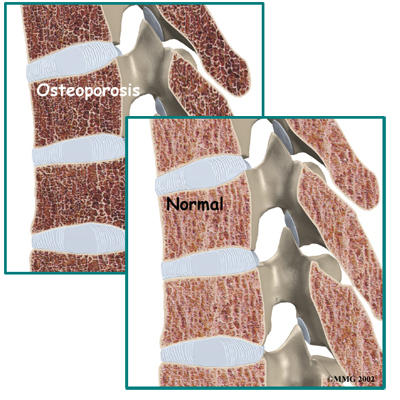Patients with osteoporosis or those at risk of developing this condition will benefit from working with a physiotherapist at One Wellness.
The goals of our physiotherapy treatment are to:
- Educate you about proper posture
- Teach you safe ways of moving and lifting
- Show you exercises you can do at home to help reduce the loss of bone mass and prevent fractures
The exercises we prescribe will particularly focus on activities that help increase the strength of your bones, as well as exercises that help maintain or improve your balance. Learning how to maintain optimum balance decreases your risk of falling, which can easily fracture an osteoporotic bone. We will also suggest exercises for your flexibility to help decrease stress that is typically placed on the bones by tight muscles. In addition, the therapeutic exercises we recommend can help improve your overall mobility.
If you have experienced a fracture due to osteoporosis, physiotherapy at One Wellness can also help control your pain and allow you to gradually return to your regular activities. One of the most important aspects we aim to correct during therapy is poor posture.
Maintaining good posture is of utmost importance if you have osteoporosis. A curved upper spine posture, called kyphosis, is common in osteoporosis due to the wedge-like fracturing of the thoracic spine (middle portion of your spine) that often occurs. This type of injury develops when the front part of the vertebrae (spinal bones) collapse leaving the posterior portion (back of the vertebrae) in a higher position, creating a wedge-like appearance. These types of fractures cause the loss of height.
For this reason, accurately measuring and recording your body height is a key part of our physiotherapy evaluation. A height measurement gives your physiotherapist an idea of how osteoporosis is affecting your bones and posture, and comparing the recordings over a period of time can help us track your success with treatments.
With posture exercises, the goal is to get your body lined up from head to toe, with weight going through your hips. In a healthy spine posture, the head is balanced on top of the spine, rather than tilted forward, which is common in osteoporosis.
In people with advanced osteoporosis, the upper body is also commonly bent forward at the hips. This prevents the hip bones from maintaining proper trunk positioning, which causes too much weight and stress to be placed on the hips. As a result, the bones weaken and become more prone to fracture. It is therefore important at all times to try to “stand tall,” as this can both prevent the loss of height and help you regain height lost from a fractured osteoporotic spine.
Your physiotherapist will describe different strategies that can help you put good posture into practice. This is called body mechanics, which is the way you align your body while performing daily activities. Remember that a healthy posture is balanced with the body aligned from the head to toe. The same posture should be used when you bend forward to pick up objects. Instead of rounding out your shoulders and upper back, keep the back in its healthy alignment as you bend forward at the hip joint. This keeps your back in a safe position.
When bones are weakened from osteoporosis, rounding the spine forward while bending and lifting pinches the front section of the vertebrae and increases the risk of a spine fracture. This pinching is exacerbated when any weight is lifted in this position. Even the weight of a purse or shopping bag can add detrimental stress to an osteoporotic spine, leading to a fracture. Along with maintaining proper posture, gently tightening the muscles around your core area can also help protect the back during activities such as lifting. Your physiotherapist will educate you on how to use your core muscles to protect your spine. Individuals with an osteoporotic spine who rapidly bend forward, such as that experienced when one sneezes or coughs, can be enough to cause a spinal fracture. Due to this issue, your physiotherapist will educate you on consciously extending your back instead of flexing your spine during these activities.
Another motion that is particularly stressful for an osteoporotic spine is a twisting motion. The normal structure of bone is not designed to withstand twisting very well, and combined with the weakened bone state of osteoporosis the twisting motion can easily cause a fracture. Although it is difficult to eliminate twisting movements from everyday life, this movement should be avoided whenever possible, especially for activity that requires higher-velocity motions such as a golf swing, tennis swing, or bowling action. In addition to learning posture exercises that can be used for everyday movements, strengthening exercises for your bones are also an important part of maintaining the health of osteoporotic bones.
Remember that as your muscles get stronger, the bones underneath them also get stronger as they react to the added stress placed on them. In this way, strength training and weight-bearing activities force the bones to build mass. Your physiotherapist will prescribe some gentle weighted exercises, using either elastics or weights, for your upper and lower extremities. Using an appropriate weight is vital and your physiotherapist can educate you on how much resistance is appropriate for you.
If you are using free weights, handling the weights is just as important as doing the actual exercises. Never lift weights in the flexed forward posture that was described above, and be careful to gradually increase the resistance you use, as weights that are too heavy will gradually cause your body to slip into the flexed forward posture that is detrimental to people with osteoporosis. Performing exercises while your upper back is properly supported by good postural alignment is also recommended to avoid added stress on the thoracic spine.
Exercises that involve flexing the spine, such as toe touches, abdominal crunches, and dead lifts, should strictly be avoided. Carefully guided strengthening exercises for your upper back will be encouraged by your physiotherapist to counteract curved forward posturing.
Weight-bearing cardiovascular exercises such as walking outdoors or on a treadmill, gentle non-pounding forms of dance, and stair climbing are useful activities that help balance weight placed on the bones. These exercises also encourage an upright posture while improving cardiovascular health.
Although a lot of people enjoy cycling, it is not a recommended activity as it does not provide the benefits of weight bearing and it also causes the detrimental flexed forward posturing of the spine. In addition, pool exercises are not weight bearing, so they are not recommended unless severe pain from osteoporosis limits physical activity on the ground, in which case exercising in the pool would be acceptable and recommended. High-impact activities such as running, jumping, and stomping forms of dance should be strictly avoided. Your physiotherapist at One Wellness can educate you on safe cardiovascular activities specific to your interests and physical needs.
The next part of our treatment will focus on your balance. Poor balance can lead to a fall, which can easily fracture an osteoporotic bone. In some cases, a fracture from a fall can be a potentially life-threatening situation. Exercises that help improve your balance can be as simple as standing with your feet close together, standing on one foot, or standing with one foot in front of the other. Closing your eyes can make any of these activities even more challenging, but in a beneficial way. By challenging your body, your reaction time to unexpected situations such as tripping will improve and your likelihood of falling will decrease. The most important aspect of improving your balance is ensuring that you are doing it in a safe environment. Your physiotherapist will provide you with exercises that are specific to your current level of balance. As your balance gets better, more challenging exercises will be provided. Tai chi, which is an exercise form originating in China, is a great way to enhance balance, and many patients benefit from practicing this activity on a regular basis.
The final component of our treatment at One Wellness is to provide you with flexibility exercises. By improving and maintaining your flexibility, the stress put on your bones by tight muscles will decrease and the ability to practice good posture and body mechanics will increase. Heightened flexibility also improves your mobility, which in turn enhances your balance and decreases your risk of falls. In addition, stretches for your upper back and chest will be prescribed to decrease the likelihood of developing a curved posture. Stretches for your hips, calves, and neck are also important if you have osteoporosis and will be included in your stretching regimen.
Your physiotherapist will continue to compare your test results for body height, posture, strength, balance, and flexibility to see how well you are progressing and to encourage you to continue with your exercise program. Once you can safely and proficiently perform your home exercise program, regular visits to One Wellness will not be required. However, we will continue to be a resource for any further questions you may have or problems you may encounter.
If you are seeing one of our physiotherapists at One Wellness because you have recently had a fracture related to osteoporosis, our treatment will initially focus on decreasing your pain. We may use hands-on treatment as well as modalities such as ice, heat, ultrasound, or electrical current to assist in managing your pain. We will liaise with your doctor to determine the best time to begin more advanced exercises involving strengthening, balance, and flexibility, and will proceed with them when appropriate to allow you to return to your normal activities as quickly as possible.
One Wellness provides services for physiotherapy in Canmore.





 (403) 679-7179
(403) 679-7179  concierge@one-wellness.ca
concierge@one-wellness.ca 

